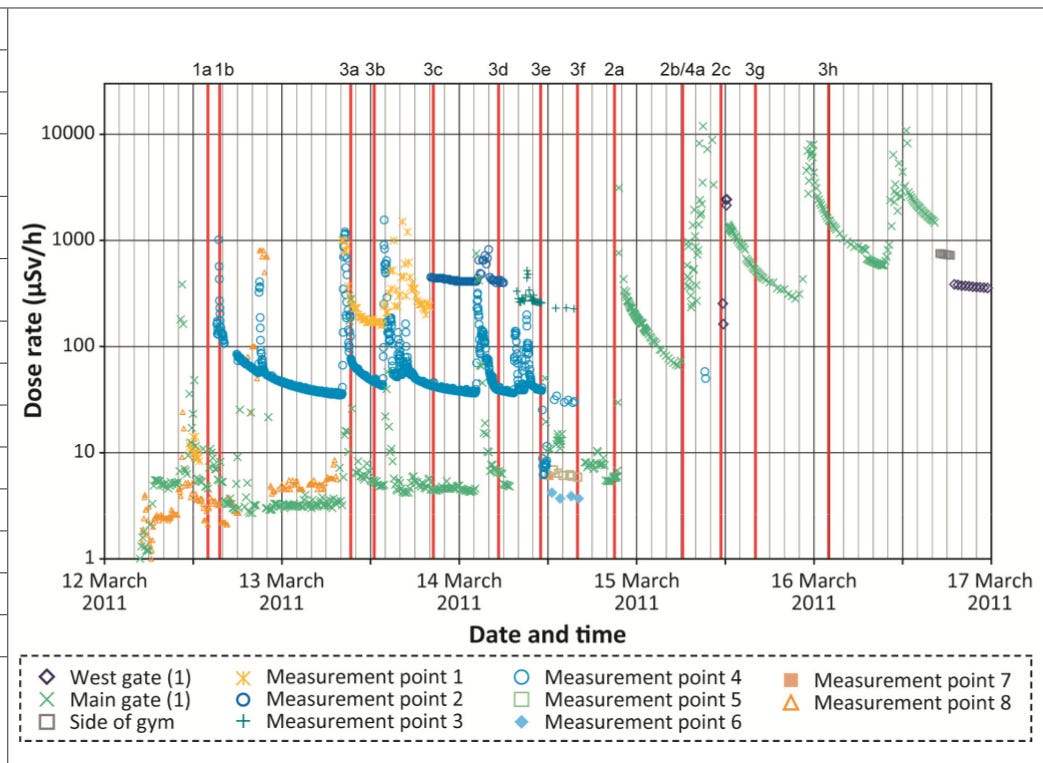Nuclear Power Plants Need Buffer Zones
I spend most of my time on substack complaining about our absurdly exaggerated fear of low dose rate (2 mSv/d or less) radiation, fostered by the nuclear establishment, for motives ranging from perverse regulator incentives to institutional greed. Lauriston Taylor, a preeminent pioneer in radiation safety, said it best:
Collectively, there exists a vast array of facts and general knowledge about ionizing radiation effects on animal and man. It cannot be disputed that the depth and extent of this knowledge is unmatched by that for most of the myriads of other toxic agents know to man. No one has been identifiably injured by radiation while working within the first numerical standards first set by the NCRP and then the ICRP in 1934. [1 mSv/day] [Lauriston Taylor, founder and first president of the National Council on Radiation Protection and Measurements, 1980]
Taylor estimated his personal life time dose at 10,000 mSv, most of which was received in 1929 due to a screwed up x-ray machine at the National Bureau of Standards. Taylor died in 2004 at the age of 102.
But high dose rates (20 mSv/day and above) can be dangerous. And a generous margin would be prudent and sensible. With the exception of childhood thyroid dose rates from I-131 contaminated milk, at both Fukushima and Chernobyl, the worst case dose rates to the public were less than 20 mSv/day, in the case of Fukushima much less. A critical factor here was the buffer zones.
At Chernobyl, the closest permanent residence to the plant was about 3 kilometers from Unit 4. At Fukushima, the closest permanent residence to the units that had containment breaches was more than 1 kilometer. The worst case public dose rates would have skyrocketed, if people had been living closer to the reactors.
Figure 1 shows the hourly ambient dose rates through time at various measuring points near the Fukushima plant periphery. Figure 2 shows the location of the instruments. From March 13 to 15, the plume moved to the North and Northwest, after which the flow turned southwest. There is a sharp spike after each release event. The ambient daily dose rate peaked on the 16th at the Main Gate at about 83 mSv/d. Absorbed dose rate tends to be about a quarter of the ambient. Sheltering indoors can cut this by a factor of 5 or more. But still this dose rate is clearly unacceptable for the public. The Main Gate is about 1 km from the damaged reactors. For a plant this large, a buffer zone of approximately 2 km is indicated.
Fgure 1. Dose rates at Fukushima Plant Boundary
Figure 2. Fukushima Plant Layout
To first order, the dose rate goes as distance squared, at least in the first few kilometers from the source. If we accept a non-linear dose-response curve such as Sigmoid No Threshold, the harm goes at better than the dose rate squared. Putting this together, the harm goes as distance to the fourth power or more. Doubling the distance, decreases the harm by a factor of 16.
This has implications for micro-reactors. The buffer zone does not decrease nearly as rapidly as the power. Suppose we decide that 2000 m is an acceptable buffer zone for a 1000 MW reactor. I'll spare you the math; but, to end up with the same worst case harm for a 1 MW micro-reactor, you need a 365 m buffer zone. You cannot put a micro-reactor in the middle of a city block.
The plant property itself can be part of the buffer zone. At Fukushima, it was almost the entire buffer zone. But the portion of the buffer zone outside the plant need not be fenced off. It could be a park or farmland, areas that people visit temporarily, areas that can easily be emptied of people with almost no disruption. In a release, they should be advised to go home and shelter-in-place.
The requirement for a buffer zone can be turned into a plus. Most nuclear plants are on the water. In the 1960's, the California State Resources Agency strongly supported nuclear. They realized that the buffer zones could be turned into state parks and beaches, assuring public access to the ocean. That shore front was protected from private development. Nuclear power plants need not use up shoreline; they can preserve it.




500 miles is roughly 5% loss with 700 kV AC. We can go farther with higher voltage and/or DC. Only a tiny proportion of the US population is more than 500 miles from the coast or a navigable river (including the Great Lakes). How many times do I have to tell you guys, do the easy stuff first.
The important feature of Natrium is its a breeder. An economically successful breeder would be a wonderful step forward. But I doubt if even Gates and buddies can pull it off in the USA. If I were Gates, I'd head to some 3rd world country where I have done a lot of medical good, and cash in those chips.
The Natrium tank is a silly add on, but in an NRC-like regulatory regime, it could play a role in keeping the regulator out of the turbine hall.
Charles,
Whatever the reactor technology, I can come up with multiple scenarios which result in a release, but if I'm being really lazy I'll just postulate a bunker buster. What's standing in the way of nuclear power is unbridled, perversely incentivized regulation. If it were replaced by an underwriter based regulation, I can assure you the insurer will want a buffer zone. At a minimum, your premium will depend on the extent of your buffer zone.